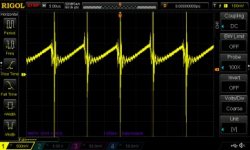Silvio
Well-known member
Hi Brady, I did not design the over current circuit but copied it from Ludo 3232 schematic. All I know that it works well but it does not reset by itself. In your case you need a current limiter which will limit current according to your setting. This is going to be a bench supply so you will need it to work this way. Why not sense the dc output voltage instead and a 0.1 or 0.2 ohm resistor will do the job for you. it can either shut off the IR2110 or the SG3525 they both have a shut down pin. You can sense both outputs separately with 2 comparators thus having adjustable current sense for each side. you need an opto coupler here for isolation.
As for the diodes I used 1n4148 cheap and work well
Regards,
Silvio
As for the diodes I used 1n4148 cheap and work well
Regards,
Silvio

